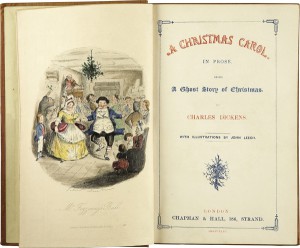 The novella A Christmas Carol by Charles Dickens has become an important part of Christmas tradition.
The novella A Christmas Carol by Charles Dickens has become an important part of Christmas tradition.
The timeless appeal of this story can be attributed to its powerful message. During the Christmas season we all want to believe that we can turn away from selfishness and permanently open up our lives and our hearts to others.
A Christmas Carol and Six Sigma
Dickens’ classic holiday story not only inspires us with the hope that we can change our lives and become better people, but also illustrates the Six Sigma approach for problem solving and process improvement.
The Jacob Marley of Six Sigma – At the beginning of the story, Ebenezer Scrooge doesn’t realize that he needs to change. It takes a visit from his deceased business partner Jacob Marley to help Scrooge see the defects and errors in the way he lives his life.
Similarly, organizations also need to be convinced of the need for change. Project teams do this in the Measure phase of the DMAIC process by using three different tools to act as their Jacob Marley and graphically display process defects.
Histogram – Illustrates how the process is performing and how process data is distributed. It helps determine if the process is capable of meeting the customer’s requirements.
Pareto Chart – This tool uses a simple visual format to display the severity of problems in a process. It helps the project team focus on solving the problems that have the greatest impact on performance.
Run Chart – This chart focuses attention on vital changes in the process over time and tracks useful information for predicting trends.
The ghosts of Six Sigma – One of the most memorable elements of the story is that Scrooge is visited by three supernatural beings and each one plays different role in causing him to transform his life. There is a parallel in Six Sigma methodology with the roles that different individuals play in the belt system. Like the ghosts, Six Sigma belts are given different responsibilities.
Master Black Belt (MBB) – This role provides training and coaching for lower belt levels. MBBs also work to ensure that Six Sigma principles are applied correctly throughout the organization. They also play an active part in creating organizational dashboards and project standards.
Black Belt – Six Sigma is a full-time job for Black Belts. They work closely with project teams to provide leadership that ensures that projects use Six Sigma principles correctly.
Green Belt – Green Belts help select Six Sigma projects and assist in creating project teams. They play a key support role by collecting data and effectively using Six Sigma tools.
The Tiny Tim of Six Sigma – In the story, Tiny Tim provides powerful motivation for Scrooge. Tim helps make sure that Scrooge’s change of heart is a lasting one so there won’t be an empty place at Christmas dinner next year.
The Change Acceleration Process (CAP) is Six Sigma’s equivalent to Tiny Tim. CAP helps to ensure that the changes implemented by the project team will last by helping employees understand and accept the changes.
In A Christmas Carol, Scrooge experienced a dramatic transformation. Six Sigma principles can help project teams make equally dramatic changes to defective processes in organizations around the globe.
